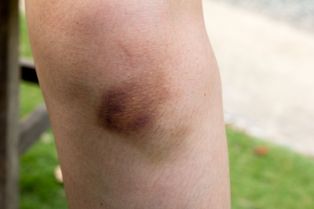
A contusion is a common injury that affects the skin. A contusion causes skin discoloration. Blood from damaged blood cells deep beneath the skin accumulates near the skin surface, this leads to a black and blue mark.
When blood vessels are damaged or broken after a hard hit or bump to the skin, this results in what is known as a contusion. These damaged vessels cause blood to leak out into the surrounding tissue; this makes the area to turn into purple (visible out of the body). A contusion can be painful when touched; this is because the blood stored beneath the skin is putting pressure on the surrounding nerve endings.
A contusion is common among athletes that engage in sports that involve contact. Based on hierarchy, a contusion is the second leading cause of sports injuries after strains.
Most cases of contusion are minor and recovery is rapid as it can be cured without taking the athlete away from the game. But severe contusion can result in deep tissue damage and complications that can prevent an athlete from playing for months.
What are the Causes of a Contusion?
Contusion usually occurs when an individual collides with something or when they got hit by something.
1. A contusion may appear in some individuals who participate in vigorous exercise; this is common among athletes and bodybuilders. These contusions can occur as a result of microscopic tears in the blood vessels underneath the skin.
2. Unexplained contusion which appears easily or for no obvious reason may indicate a bleeding disorder, especially if the contusion is followed by repeated nosebleeds or bleeding gums.
3. Frequently, what is assumed to be an inexplicable contusion on the skin or the thigh, for example, this actually occur as a result of bumps into a bedpost or other object and does not remind you of injury.
4. Contusion in aged individuals usually occurs because their skin has become thinner as they grow old. As a result of this, the tissues that support the underlying blood vessels have become more fragile.
A contusion can also occur in individuals who take drugs in order to thin their blood.
Many cases of contusion occur as a result of physical injury. Some fundamental conditions can cause contusions more often. Some examples are listed below:
1. Sports injuries. These are the types of injuries which occur amid exercise or playing sports. They include fractures, strains, and sprains, dislocations, torn tendons and swelling of the muscles.
2. Thrombocytopenia. This is known as a platelet count which is lower than the normal level. This can be caused by different conditions. Symptoms differ in severity. Observable symptoms may include red, purple dots or brown bruises, a rash with small red or purple dots, nosebleeds, and bleeding gums.
3. Leukemia. This term is used to describe several types of blood cancer that occur when white blood cells in the bone marrow grow out of control. Sweating profusely, especially at night, fatigue and weakness that does not go away with sleep, unintended weight loss, bone pain, and tenderness are the common symptoms.
4. Ankle Sprain. An ankle sprain is an injury that affects the ligaments which surround and joins the bones of the leg to the foot. Possible symptoms include swelling, tenderness, bruising, and pain, finding it difficult to put weight on the affected ankle, skin discoloration, and stiffness.
What are the Symptoms of a Contusion?
At first, a fresh contusion may be reddish. After some hours, it then turns blue or dark purple, then yellow to green after a few days as it heals.
A contusion is usually tender and sometimes can be painful during the first few days, but the pain usually disappears as the color fades. Since the skin is not broken in a contusion, there is no risk of infection.
Contusion Treatment
Treatment for a Contusion requires restoring the circulation and blood flow to the affected structures in your injured area. Pain is caused when swelling, inflammation and decreased circulation generate a blockage, which causes blood flow to be interrupted or slowed. Treatment for this issue requires breaking up the accumulated fluids in your injured area to allow for improved healing and quicker recovery.
Products recommended for symptoms of swelling, redness, pain, and inflammation, and if coolness makes your pain feel better:
Ice Substitute Poultice
Bruise Relief Liniment
Muscle Therapy Massage Oil





